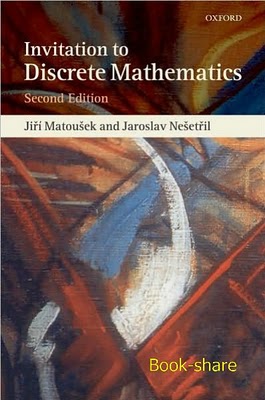Course description
MAS 275: Discrete Mathematics
This course offers a basic introduction to discrete mathematics. This includes mathematical induction, combinatorial counting, and elementary graph theory. Ramsey theory and the probabilistic method will also be introduced.
Lectures
Time Tuesdays and Thursdays, 10.30 - 11.59am
Room 3435, Building E6-1
Lecturer Andreas Holmsen
Office hours TBA
Syllabus
An invitation to discrete mathematics
J. Matousek and J. Nesetril, 2nd edition, Oxford Unuiv Press, 2008.
Chapters to be covered:
1. Introduction to basic concepts
2. Orderings
3. Combinatorial counting
4. Graphs: and introduction
5. Trees
6. Drawing graphs in the plane
7. Double counting
8. The number of spanning trees
9. Finite projective planes
10. Probability and probabilistic proofs
(Certain subsections may be omitted due to time
constraints)
Homework
Homeworks will be handed in as team projects. Each team will consist of 4 students, and will be decided in the first week of the semester. You can not change teams during the semester. Teams should meet at least twice a week to discuss the homework problems. The homework should be written in the quality that can be shown to other students without any modification, and submitted in time. Late submissions will not be accepted.
Each homework should contain a cover sheet with the
following information:
(1) List of team members and student IDs
(2) Dates, times, and locations of team meetings
Homework solutions should be typed in LATEX (preferred) or
HWP/MS-Word,
and submitted on the KLMS-website.
Teaching Assistants
For questions regarding the homeworks, please contact me or the TAs through the KLMS-website.
Kim, Minki
Lee, Dongmin
Exams
Midterm exam
April 25: 10.30 - 13.30, Room 3435 (usual lecture room)
Final exam
June 20: 10.30 - 13.30, Room 3435 (usual lecture room)
Grading
Midterm (35%), Final (35%), Homework (25%), Class participation (5%)
The final grades are distributed as follows
Total score
≥ 90% ⇒ A
≥ 80% ⇒ B
≥ 70% ⇒ C
(Students who do not take the midterm or final exam will
get an F)
Advice
Try to solve the problems in the book. Solve as many as possible, preferably all of them. The problems in this textbook introduce new ideas and concepts. Although we will learn some basic techniques, discrete math requires creativity and intuition rather than standard methods. To truly master the material of this course requires experience, which is gained by problem solving.
